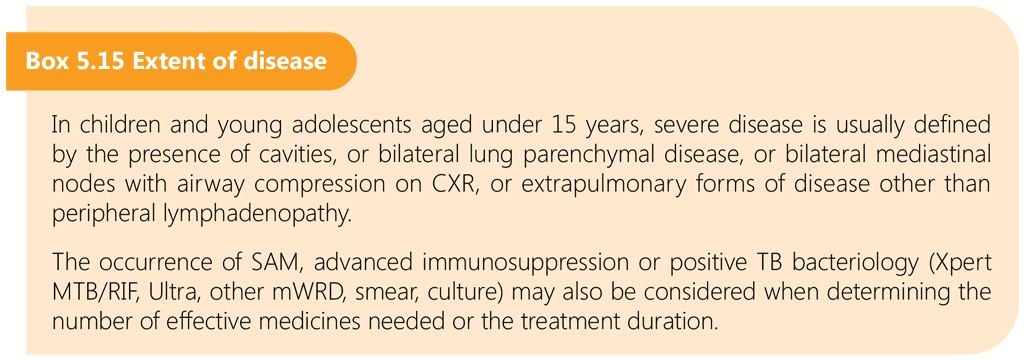Book traversal links for 5.3.2.3. Longer individualized regimens for children with multidrug-resistant and rifampicin-resistant TB who are not eligible for the standardized all-oral bedaquiline-containing regimen
Children who are not eligible for the standardized all-oral bedaquiline-containing regimen include those without bacteriological confirmation (e.g. with a clinical diagnosis); or without fluoroquinolone resistance ruled out (in their own specimens); or with drug-resistant EPTB other than peripheral lymphadenopathy; or with extensive pulmonary disease; or with prior exposure for more than 1 month to the medicines in the shorter regimen.
These children should be treated with longer, individualized treatment regimens. In general, the treatment principles for MDR/RR-TB in children follow those recommended for adolescents and adults.
The following treatment considerations apply specifically for children with MDR/RR-TB (82, 84):
- Individualized regimens should consist of at least four medicines to which the organism is likely to be susceptible. Most medicines will be used for the duration of treatment, but some may be used for shorter periods, such as bedaquiline (recommended for 6 months) or linezolid (often used for shorter durations because of its potential for severe adverse effects). Children and adolescents with extensive forms of MDR/RR-TB may benefit from an additional fifth medicine at least at the beginning of treatment, with the duration depending on the extent of disease, response to treatment, number and efficacy of companion medicines in the regimen, and potential for adverse effects (see Box 5.15).
- Group A and Group B medicines should be prioritized in the construction of the treatment regimen, as well as delamanid and other Group C medicines (the medicines in Group C in Table 5.11 are ranked by the relative balance of benefit and harm).
- For children of all ages, bedaquiline is recommended to be included as part of individualized treatment regimens. Pharmacokinetic and safety data, especially in children aged under 5 years, are limited. The recommended standard duration of treatment with bedaquiline is 6 months. Extension of bedaquiline beyond 6 months may be considered in some people without other options (e.g. those with fluoroquinolone resistance or intolerance to linezolid), in consultation with a paediatric DR-TB expert and with strict baseline and follow-up monitoring. In 2019, a guideline development group assessed evidence to determine whether bedaquiline could be used beyond 6 months. Owing to limited evidence and potential residual confounding in the data, the guideline development group was not able to make a statement about the relative efficacy of using bedaquiline beyond 6 months, but it was able to conclude that it was safe to do so, provided appropriate schedules of monitoring are in place.
- Linezolid is a Group A medicine that has been associated with frequent haematological toxicity, depending on the dose and duration of use. Its use for the full duration of treatment may improve efficacy, but adverse events may limit the duration of use to the first few months (see Section 5.3.4). If there are few options available, such as for TBM caused by an MDR/RR-TB strain or for MDR/RR-TB with additional fluoroquinolone resistance but linezolid susceptibility, linezolid can be continued for longer durations, such as 6–9 months or longer as adverse effects allow.
- For children of all ages, delamanid is an option to add to MDR/RR-TB regimens if the child has (suspected) fluoroquinolone resistance or severe disease necessitating a fifth medicine. The recommended standard duration of treatment with delamanid is 6 months. Data on its use beyond 6 months have not been assessed by WHO.
- If the regimen cannot be composed with sufficient effective Group A or Group B medicines, addition of ethambutol and/or pyrazinamide (if DST of the child or source case confirms susceptibility) can be considered. Due to difficulties in interpreting its DST, ethambutol should be considered only when it is likely to be effective. P-aminosalicylic acid is another Group C medicine that can be used in children and adolescents if new medicines are not available or a four- or five-medicine regimen cannot be constructed.
- Ethionamide/prothionamide should be used as an additional medicine only if there is no known or suspected inhA mutation. Ethionamide should be reserved for situations where more effective medicines (e.g. bedaquiline, linezolid, clofazimine) cannot be used (116).
- In children with fluoroquinolone resistance or with limited treatment options, extension of bedaquiline beyond 6 months and/or a combination of bedaquiline with delamanid may be considered. Data in adults show the combination of bedaquiline and delamanid does not result in a marked increase in adverse events, including QT prolongation (117). Data on concurrent use of bedaquiline and delamanid in children are limited, but there is no reason to expect this would not be similarly safe in children. Careful monitoring of QT prolongation is strongly recommended when these medicines are used together (84).
- Injectable agents (amikacin, streptomycin) should not be used in children because of their risk of permanent hearing loss and their poor tolerability. Hearing loss is a frequent severe adverse effect of aminoglycosides, with a profound impact on language acquisition, ability to learn at school and further development. Amikacin may be included in the treatment of MDR/RR-TB only in people aged 18 years and over on longer regimens when susceptibility has been demonstrated and adequate measures to monitor for adverse reactions can be ensured. If amikacin is not available, streptomycin may replace amikacin under the same conditions.
- Duration of treatment using individualized regimens in children depends on the site and severity of disease (see Box 5.15) and the extent of resistance (in addition to isoniazid and rifampicin resistance). Children with non-severe disease can usually be treated for less than 18 months. Children with extensive disease may require longer treatment durations, depending on clinical progress, site of disease (e.g. bone or CNS), resistance pattern and number of types of medicines likely to be effective (82).
- Child-friendly formulations should be used whenever possible.
- Monitoring and management of adverse events are essential.

 Feedback
Feedback